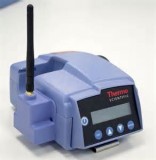
The pDR-1500 is a highly sensitive nephelometric (i.e., photometric)
monitor whose legacy light scattering sensing configuration has been
optimized for the measurement of the respirable fraction of airborne dust,
smoke, fumes and mists in industrial and other indoor and outdoor
environments. The pDR-1500 incorporates a temperature and relative
humidity (RH) sensor to mitigate the positive bias with elevated ambient
RH. Additionally, the flow control is truly volumetric and is maintained
through digital feedback of the onboard barometric pressure sensor,
temperature sensor, and calibrated differential pressure across a precision
orifice.
Downstream of the internal vacuum pump is a HEPA filter which will
ensure a clean air source is delivered to the calibrated orifice and exhausted
from the instrument. Zeroing is accomplished using one of two methods.
The primary zeroing method is accomplished by attaching a HEPA filter to
the total inlet for a few minutes. A second zeroing method is the “field
zero” by which a piece of tubing is attached to the exhaust port and recirculated
to the inlet. This second method was developed to reduce the
potential loss of accessories in the field, while providing a reasonably
accessible method for zeroing. By providing filtered air through the optical
bench, the optical background of the instrument is established throughout
the dynamic range of the instrument.
The pDR-1500 is a compact, rugged and totally self-contained instrument
designed for hand-held, belt-worn, as well as unattended operation. It is
powered either by its internal replaceable batteries, or by an AC supply
(included as standard accessory).
The pDR-1500 covers a wide measurement range: from 0.001 mg/m3
(1
μg/m3
) to 400 mg/m3
, a 400,000-fold span, corresponding to very clean air
up to an extremely high aerosol concentration.
In addition to the auto-ranging real-time concentration readout, the pDR-
1500 offers the user a wide range of information by scrolling its two-line
LCD screen, such as run start time and date, time averaged concentration,
elapsed run time, maximum and STEL values with times of occurrence,
battery voltage, data storage memory, temperature, RH, volumetric flow
rate, barometric pressure, etc.